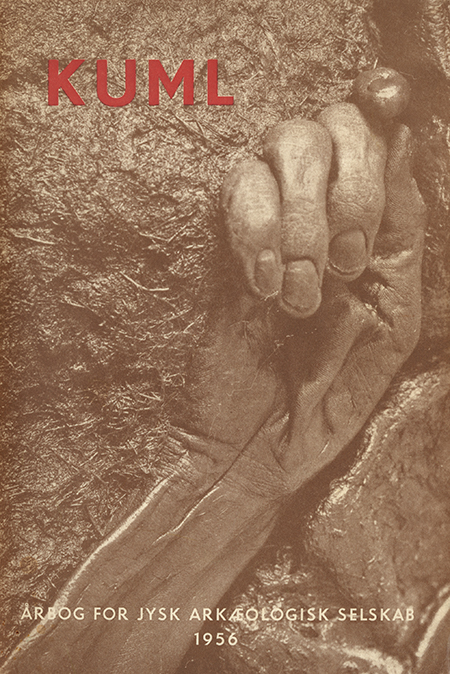Vindblæs-fundet
DOI:
https://doi.org/10.7146/kuml.v6i6.97287Nøgleord:
Roman iron age, grave, ceramic grave, romersk jernalder, grav, keramik grav, Nordjylland, North Jutland, Mølgaard, vindblæsResumé
Vindblæs - a West Himmerland Bronze-Smithy
On a high-lying stretch of country, falling gradually southwards towards the headwaters of the River Bjørnsholm, stands a row of small tumuli, most of which have been ploughed over. One of this row lies on the property known as Mølgaard in Vindblæs Parish, Slet Herred, a low tumulus most resembling a ploughed-out single-grave burial mound.
In the course of cultivation the owner struck stone in this tumulus and, digging it up, found potsherds. He reported his discovery to Mr. Bent Jensen, a dental mechanic of Løgstør, and gave him permission to excavate. The excavation revealed a grave of Roman Iron Age date in the centre of the tumulus, a grave of typical North Jutland type containing six pottery vessels, an iron knife and a crescent-shaped iron razor.
But the excavation also revealed that the earth surrounding the grave was full of ashes and charcoal, scattered potsherds and cremated bones, and that this layer extended to the edge of the tumulus, which proved to be surrounded by a ring of stones (Figs. 1-4). In consultation with the West Himmerland Museum it was decided to excavate the mound to its full extent. It was found that the stone ring was circular, 9.8 metres in diameter, and formed of stones ranging in size from a cricket hall to a football. Adjoining the circle on the southeast side was an irregular paving, mainly of the larger size of stone, 3 metres long and of about the same width. It rested on a heap of sand sloping to the east and containing a streak of reddish ash (Fig. 3). The occupation level, resting on the original ground surface and covering the whole area within the stone ring, was about 25-30 cms. thick in the centre and fell away gradually to the sides (Fig. 4). It was full of red, yellow and white ash and a considerable quantity of charcoal.
In the northern half of the area the occupation earth covered a heap of yellow gravel, extending over about 4 square metres and very different in composition from the subsoil gravel of the site. In addition there were two paved areas of split flags of a reddish stone; many of the flags were blackened and scorched, and the earth below them was black and full of charcoal.
Throughout the occupation earth a large number of fragments of pottery, casting moulds and crucibles showed the use to which the site had been put, but, despite the careful excavation technique employed, the collection of every scrap of material and a long period spent fitting the scraps together, only a very few vessels and moulds have proved capable of reassembly.
703 potsherds were found, mainly of coarse thick-walled vessels: Rim-sherds of 20-25 vessels and bases of 8-10 were identified. Only a small beaker (Fig. 5) could be reassembled, but the few sherds which could be fitted together to show a profile all reveal a slight S-shaped side, various heights of neck and a more or Jess steep-sided body 2). They indicate the Late Bronze Age. A few sherds of thinner ware, of 4-5 vessels, decorated with open multiple zigzags between horizontal lines 3), give a closer dating.
173 fragments of moulds were found, all of "true" moulds, which could be repeatedly reused. They were formed of sand-tempered clay, with an interior slip of fine clay. The majority are moulds for spearheads, though moulds for pins and torques were also found. Only a few of the moulds allow the type of object cast in them to be determined with certainty. Two halfmoulds, fitting together, could be assembled to form the mould of a spearhead, 16 cms. long, of a very simple type used throughout the Bronze Age and into the lron Age (Figs. 6 and 7).
The crucibles were of small hemispherical form, with one side drawn out into a spout. They are of sand-tempered clay but heat has given the inner surface a hard glaze-like layer, sometimes stained with copper oxide. 78 fragments of crucibles were found, the majority 6-7 cms. in diameter, though one was about 12 cms.
In the layer was found in addition a number of fragments of burnt bone, and three coarse flake scrapers, three blades and two "strike-a-lights", all of flint. There was a surprisingly large quantity of flint waste, in the northern half of the circle alone some 2500 fragments, of which a large part were in a single heap on the original ground surface. In addition three fragments of a four-sided bronze pin, some polishing stones and a remarkable oval smoothing stone, 13 cms. long, with a flat polishing surface on one side and on the other a rough groove across the width of the stone, were discovered.
There is a single discovery in Denmark which corresponds exactly to that at Vindblæs - the site at Haag in Thorsager Parish on Djursland investigated by Carl Neergaard in 1895 4). In Sweden there have been at least four discoveries made which in all important details resemble these two Danish sites.
S. Vestergaard Nielsen
Downloads
Publiceret
Citation/Eksport
Nummer
Sektion
Licens
Fra og med årgang 2022 er artikler udgivet i Kuml med en licens fra Creative Commons (CC BY-NC-SA 4.0).
Alle tidligere årgange af tidsskriftet er ikke udgivet med en licens fra Creative Commons.


